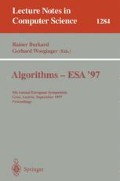Abstract
Many of the computational geometers' favorite data structures are planar graphs, canonically determined by a set of geometric data, that take Θ(n log n) time to compute. Examples include 2-d Delaunay triangulation, trapezoidations of segments, and constrained Voronoi diagrams, and 3-d convex hulls. Given such a structure, one can determine a permutation of the data in O(n) time such that the data structure can be reconstructed from the permuted data in O(n) time by a simple incremental algorithm.
As a consequence, one can permute a data file to “hide” a geometric structure, such as a terrian model based on the Delaunay triangulation of a set of sampled points, without disrupting other applications. One can even include “importance” in the ordering so the incremental reconstruction produces approximate terrain models as the data is read or received. For the Delaunay triangulation, we can also handle input in degenerate position, even though the data structures may no longer be canonically defined.
Supported in part by grants from NSERC and Facet Decision Systems
Supported in part by ESPRIT IV LTR project 21957 (CGAL).
Preview
Unable to display preview. Download preview PDF.
References
Franz Aurenhammer. Voronoi diagrams-A survey of a fundamental geometric data structure. ACM Computing Surveys, 23(3):345–405, 1991.
Marshall Bern and David Eppstein. Mesh generation and optimal triangulation. In F. K. Hwang and D.-Z. Du, editors, Computing in Euclidean Geometry. World Scientific, March 1992.
Norishige Chiba, Takao Nishizeki, and Nobuji Saito. A linear 5-coloring algorithm of planar graphs. Journal of Algorithms, 2:317–327, 1981.
M. de Berg, M. van Kreveld, R. van Oostrum, and M. Overmans. Simple traversal of a subdivision without extra storage. Int. J. of GIS, 11, 1997.
M. Deering. Geometry compression. Computer Graphics, pages 13–20, 1995. Proceedings of SIGGRAPH `95.
H. Djidjev and A. Lingas. On computing the Voronoi diagram for restricted planar figures. In WADS '91: Second Workshop on Data Structures and Algorithms, number 519 in Lecture Notes in Computer Science, pages 54–64. Springer-Verlag, 1991.
Herbert Edelsbrunner. Algorithms in Combinatorial Geometry. Springer-Verlag, Berlin, 1987.
Herbert Edelsbrunner and Ernst Peter Mücke. Simulation of simplicity: A technique to cope with degenerate cases in geometric algorithms. ACM Transactions on Graphics, 9(1):66–104, 1990.
Michael T. Goodrich and Roberto Tamassia. Dynamic trees and dynamic point location. In Proceedings of the 23rd Annual ACM Symposium on Theory of Computing, pages 523–533, 1991. To appear in SIAM Journal on Computing, 1997.
L. J. Guibas, D. E. Knuth, and M. Sharir. Randomized incremental construction of Delaunay and Voronoi diagrams. Algorithmica, 7:381–413, 1992.
Leonidas Guibas and Jorge Stolfi. Primitives for the manipulation of general subdivisions and the computation of Voronoi diagrams. ACM Transactions on Graphics, 4(2):74–123, 1985.
H. Hoppe. Progressive meshes. Computer Graphics, pages 99–108, 1996. Proceedings of SIGGRAPH `96.
D. Kirkpatrick. Optimal search in planar subdivisions. SIAM Journal on Computing, 12:28–35, 1983.
D. T. Lee and F. P. Preparata. Computational geometry: a survey. IEEE Trans. Comput., C-33:1072–1101, 1984.
Ketan Mulmuley. Computational Geometry: An Introduction Through Randomized Algorithms. Prentice-Hall, Englewood Cliffs, N.J., 1993.
Atsuyuki Okabe, Barry Boots, and Kokichi Sugihara. Spatial Tessellations: Concepts and Applications of Voronoi Diagrams. John Wiley & Sons, 1992.
Joseph O'Rourke. Computational Geometry in C. Cambridge University Press, 1994.
T. K. Peucker, R. J. Fowler, J. J. Little, and D. M. Mark. The triangulated irregular network. In Amer. Soc. Photogrammetry Proc. Digital Terrain Models Symposium, pages 516–532, 1978.
Franco P. Preparata and Michael I. Shamos. Computational Geometry-An Introduction. Springer-Verlag, New York, 1985.
Neil Robertson, Daniel P. Sanders, Paul Seymour, and Robin Thomas. Efficiently four-coloring planar graphs. In Proceedings of the 28th Annual ACM Symposium on Theory of Computing, pages 571–575, 1996.
R. Seidel. Backwards analysis of randomized geometric algorithms. In J. Pach, editor, New Trends in Discrete and Computational Geometry, volume 10 of Algorithms and Combinatorics, pages 37–68. Springer-Verlag, 1993.
Raimund Seidel. A method for proving lower bounds for certain geometric problems. In Godfried T. Toussaint, editor, Computational Geometry, pages 319–334. North Holland, Amsterdam, 1985.
Cao An Wang and Francis Chin. Finding the constrained Delaunay triangulation and constrained Voronoi diagram of a simple polygon in linear time. In Paul Spirakis, editor, Algorithms-ESA'95, number 979 in Lecture Notes in Computer Science, pages 280–294. Springer-Verlag, 1995.
Author information
Authors and Affiliations
Editor information
Rights and permissions
Copyright information
© 1997 Springer-Verlag Berlin Heidelberg
About this paper
Cite this paper
Snoeyink, J., van Kreveld, M. (1997). Linear-time reconstruction of Delaunay triangulations with applications. In: Burkard, R., Woeginger, G. (eds) Algorithms — ESA '97. ESA 1997. Lecture Notes in Computer Science, vol 1284. Springer, Berlin, Heidelberg. https://doi.org/10.1007/3-540-63397-9_35
Download citation
DOI: https://doi.org/10.1007/3-540-63397-9_35
Published:
Publisher Name: Springer, Berlin, Heidelberg
Print ISBN: 978-3-540-63397-6
Online ISBN: 978-3-540-69536-3
eBook Packages: Springer Book Archive

